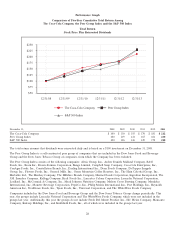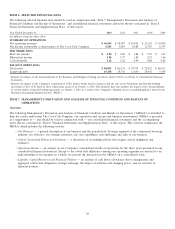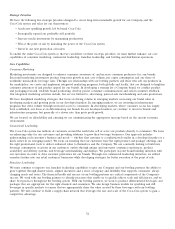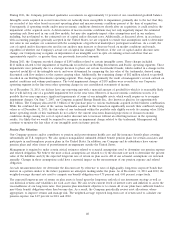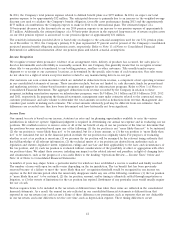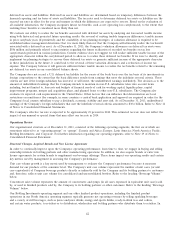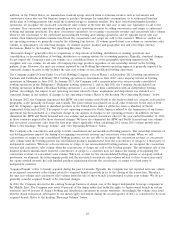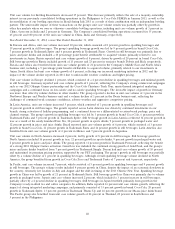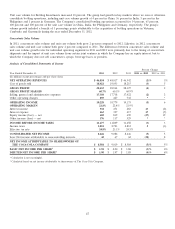Coca Cola 2013 Annual Report Download - page 39
Download and view the complete annual report
Please find page 39 of the 2013 Coca Cola annual report below. You can navigate through the pages in the report by either clicking on the pages listed below, or by using the keyword search tool below to find specific information within the annual report.
The following table presents the carrying values of our investments in equity and debt securities (in millions):
Percentage
Carrying of Total
December 31, 2013 Value Assets1
Equity method investments $ 10,393 12%
Securities classified as available-for-sale 4,842 5
Securities classified as trading 372 *
Cost method investments 162 *
Total $ 15,769 18%
* Accounts for less than 1 percent of the Company’s total assets.
1The total percentage does not add due to rounding.
Investments classified as trading securities are not assessed for impairment, since they are carried at fair value with the change in
fair value included in net income. We review our investments in equity and debt securities that are accounted for using the equity
method or cost method or that are classified as available-for-sale or held-to-maturity each reporting period to determine whether
a significant event or change in circumstances has occurred that may have an adverse effect on the fair value of each investment.
When such events or changes occur, we evaluate the fair value compared to our cost basis in the investment. We also perform this
evaluation every reporting period for each investment for which our cost basis has exceeded the fair value in the prior period. The
fair values of most of our Company’s investments in publicly traded companies are often readily available based on quoted market
prices. For investments in nonpublicly traded companies, management’s assessment of fair value is based on valuation
methodologies including discounted cash flows, estimates of sales proceeds and appraisals, as appropriate. We consider the
assumptions that we believe hypothetical marketplace participants would use in evaluating estimated future cash flows when
employing the discounted cash flow or estimates of sales proceeds valuation methodologies. The ability to accurately predict future
cash flows, especially in emerging and developing markets, may impact the determination of fair value.
In the event the fair value of an investment declines below our cost basis, management is required to determine if the decline in
fair value is other than temporary. If management determines the decline is other than temporary, an impairment charge is
recorded. Management’s assessment as to the nature of a decline in fair value is based on, among other things, the length of time
and the extent to which the market value has been less than our cost basis, the financial condition and near-term prospects of the
issuer, and our intent and ability to retain the investment for a period of time sufficient to allow for any anticipated recovery in
market value.
In 2013, four of the Company’s Japanese bottling partners merged as Coca-Cola East Japan Bottling Company, Ltd. (‘‘CCEJ’’), a
publicly traded entity, through a share exchange. The terms of the agreement included the issuance of new shares of one of the
publicly traded bottlers in exchange for 100 percent of the outstanding shares of the remaining three bottlers according to an
agreed-upon share exchange ratio. As a result, the Company recorded a net charge of $114 million for those investments in which
the Company’s carrying value was less than the fair value of the shares received. These charges were recorded in the line item
other income (loss) — net in our consolidated statement of income and impacted the Corporate operating segment. Refer to the
heading ‘‘Operations Review — Other Income (Loss) — Net’’ below as well as Note 17 of Notes to Consolidated Financial
Statements.
In 2012, the Company recognized impairment charges of $16 million as a result of the other-than-temporary decline in the fair
values of certain cost method investments. These impairment charges were recorded in the line item other income (loss) — net in
our consolidated statement of income and impacted the Corporate operating segment. Refer to the heading ‘‘Operations
Review — Other Income (Loss) — Net’’ below as well as Note 16 and Note 17 of Notes to Consolidated Financial Statements.
In 2011, the Company recognized impairment charges of $17 million as a result of the other-than-temporary decline in the fair
values of certain available-for-sale securities. In addition, the Company recognized charges of $41 million during 2011 related to
the impairment of an investment in an entity accounted for under the equity method of accounting. These impairment charges
were recorded in the line item other income (loss) — net in our consolidated statement of income and impacted the Corporate
operating segment. Refer to the heading ‘‘Operations Review — Other Income (Loss) — Net’’ below as well as Note 16 and
Note 17 of Notes to Consolidated Financial Statements.
37



